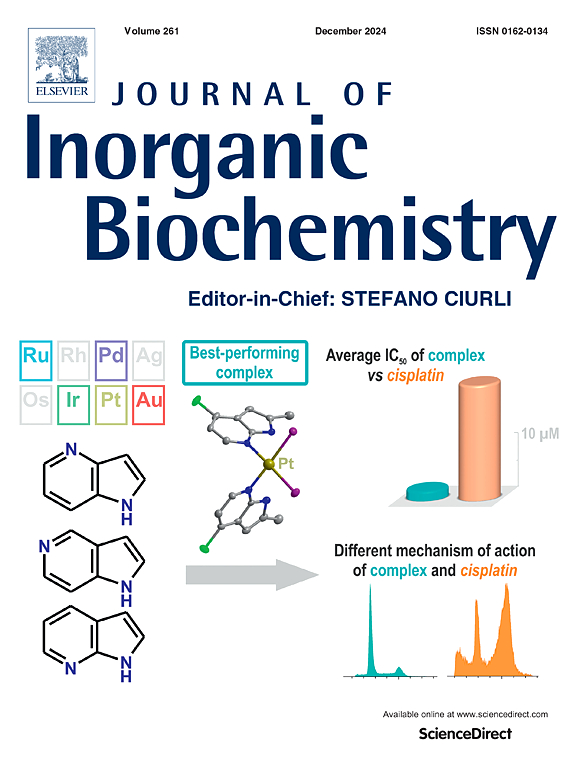肿瘤微环境响应智能纳米平台,通过协同增强谷胱甘肽耗竭和缺氧缓解协同肿瘤治疗
IF 3.2
2区 化学
Q2 BIOCHEMISTRY & MOLECULAR BIOLOGY
引用次数: 0
摘要
化学动力疗法(CDT)和光动力疗法(PDT)作为一种创新的治疗策略,在肿瘤治疗中具有广阔的应用前景。但肿瘤微环境缺氧、H2O2供应不足严重限制了其治疗效果。Juglone (JUG)是一种天然的萘醌,可以增加细胞内H2O2浓度,并作为肽基脯氨酸顺式反式异构酶nima相互作用的抑制剂1。本文设计并制备了由铁基金属有机框架核心、MnO2层、JUG载荷和透明质酸(HA)装饰(Fe-TCPP@MnO2@JUG@HA)组成的纳米平台。MnO2层可以阻止四基(4-羧基苯基)卟啉(TCPP)在运输过程中的光毒性,并催化H2O2生成O2,增强PDT效果。透明质酸可以提高对肿瘤的输送效率。然后,由于弱酸性和高浓度谷胱甘肽(GSH)的作用,Fe3+被还原为Fe2+, MnO2被还原为Mn2+,导致纳米平台坍塌、TCPP活化和JUG释放。gsh的消耗降低了活性氧(ROS)的清除作用,进一步增强了PDT的功效,抑制了脂质修复酶谷胱甘肽过氧化物酶4的生物合成,并通过破坏氧化还原平衡促进了铁沉效率。这种PDT/CDT/化疗三联效的细胞凋亡-铁下垂策略具有良好的肿瘤治疗效果和良好的生物相容性,预示着有效治疗肿瘤的前景。本文章由计算机程序翻译,如有差异,请以英文原文为准。

Tumor microenvironment responsive smart nanoplatform for synergistic tumor therapy through co-enhancement of GSH depletion and hypoxia relief
As innovative therapeutic strategy, chemodynamic therapy (CDT) and photodynamic therapy (PDT) show great promise for tumor therapy. However, their therapeutic efficacy is seriously limited by the hypoxia and insufficient H2O2 supply of the tumor microenvironment. Juglone (JUG), a naturally-occurring naphthoquinone, can increase the intracellular H2O2 concentration and serve as an inhibitor of peptidyl-prolyl cis-trans isomerase NIMA-interacting 1. Herein, a nanoplatform composed of Fe-based metal-organic framework core, MnO2 layer, JUG payload, and hyaluronic acid (HA) decoration (Fe-TCPP@MnO2@JUG@HA) was designed and prepared. The MnO2 layer can prevent the phototoxicity of tetrakis (4-carboxyphenyl)porphyrin (TCPP) during transportation and catalyze H2O2 to produce O2 to enhance the PDT efficacy. HA can improve the delivery efficiency to tumor. Then Fe3+ was reduced to Fe2+ and MnO2 was reduced to Mn2+ because of the weak acidity and high concentration glutathione (GSH), causing the nanoplatform collapse, TCPP activation, and JUG release. GSH-depletion reduce the reactive oxygen species (ROS) scavenging effect and further enhance the PDT efficacy, inhibited the biosynthesis of lipid repair enzyme glutathione peroxidase 4 and promoted the ferroptosis efficiency by destroying redox balance. This PDT/CDT/chemotherapy triple synergistic apoptosis-ferroptosis strategy exhibited good tumor therapeutic efficacy and excellent biocompatibility, implying the promising future for efficient tumor treatment.
求助全文
通过发布文献求助,成功后即可免费获取论文全文。
去求助
来源期刊

Journal of Inorganic Biochemistry
生物-生化与分子生物学
CiteScore
7.00
自引率
10.30%
发文量
336
审稿时长
41 days
期刊介绍:
The Journal of Inorganic Biochemistry is an established international forum for research in all aspects of Biological Inorganic Chemistry. Original papers of a high scientific level are published in the form of Articles (full length papers), Short Communications, Focused Reviews and Bioinorganic Methods. Topics include: the chemistry, structure and function of metalloenzymes; the interaction of inorganic ions and molecules with proteins and nucleic acids; the synthesis and properties of coordination complexes of biological interest including both structural and functional model systems; the function of metal- containing systems in the regulation of gene expression; the role of metals in medicine; the application of spectroscopic methods to determine the structure of metallobiomolecules; the preparation and characterization of metal-based biomaterials; and related systems. The emphasis of the Journal is on the structure and mechanism of action of metallobiomolecules.
 求助内容:
求助内容: 应助结果提醒方式:
应助结果提醒方式:


